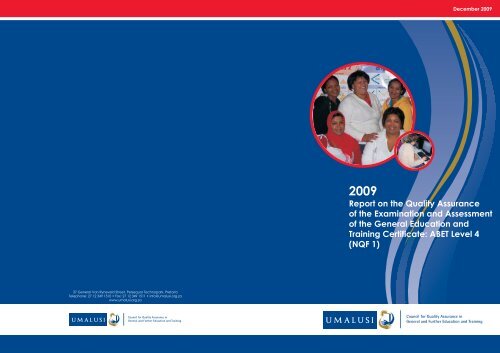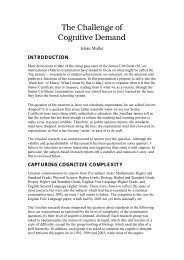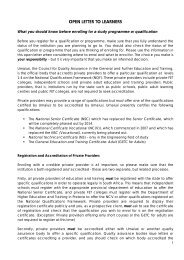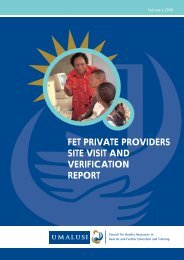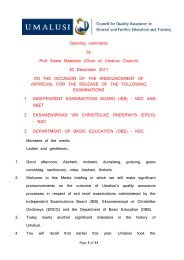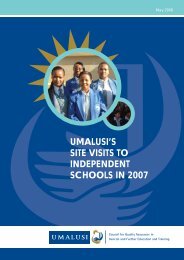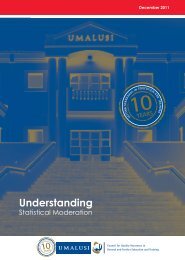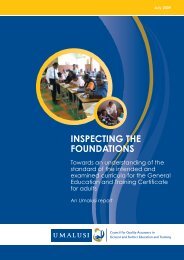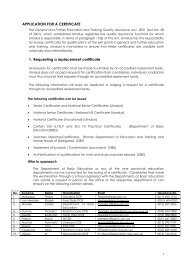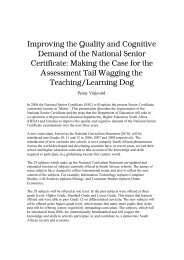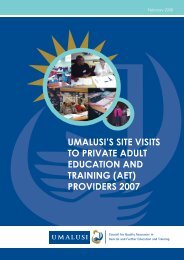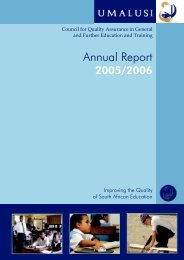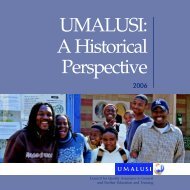ABET Level 4 - Umalusi
ABET Level 4 - Umalusi
ABET Level 4 - Umalusi
You also want an ePaper? Increase the reach of your titles
YUMPU automatically turns print PDFs into web optimized ePapers that Google loves.
REPORT ON THE QUALITY ASSURANCEOF THE EXAMINATION AND ASSESSMENT OFTHE GENERAL EDUCATION AND TRAININGCERTIFICATE: <strong>ABET</strong> LEVEL 4 (NQF 1)2009Cover Photograph credit: John Walton Adult Centre’s Teaching Staff (Uitenhage),Uitenhage District, Eastern Cape ProvincePUBLISHED BY:Council for Quality Assurance inGeneral and Further Education and Training37 General Van Ryneveld Street, Persequor Technopark, PretoriaTelephone: 27 12 349 1510 • Fax: 27 12 349 1511 • info@umalusi.org.za
COPYRIGHT 2009 UMALUSI COUNCIL FOR QUALITYASSURANCE IN GENERAL AND FURTHER EDUCATIONAND TRAINING. ALL RIGHTS RESERVED.
ContentsTABLESACRONYMSFOREWORDvviiviiiCHAPTER ONE:1. Background2. Purpose of the Report3. Scope of the ReportCHAPTER TWO: MODERATION OF QUESTION PAPERS1. Introduction2. Scope3. Approach4. Findings5. Areas of Good Practice6. Areas for Improvement7. ConclusionCHAPTER THREE: MODERATION OF INTERNAL ASSESSMENT1. Introduction2. Scope3. Approach4. Findings5. Areas of Good Practice6. Areas for Improvement7. ConclusionCHAPTER FOUR: MONITORING OF THE EXAMINATION1. Introduction2. Scope3. Approach4. Findings5. Areas of Good Practice6. Areas for Improvement7. Conclusion111133333555666781010111212121313131617iii
CHAPTER FIVE: MODERATION OF MARKING1. Introduction2. Scope3. Approach4. Findings5. Areas of Good Practice6. Areas for Improvement7. ConclusionCHAPTER SIX: STANDARDISATION OF RESULTS1. Introduction2. Scope3. Approach4. Findings5. Areas of Good Practice6. Areas for Improvement7. ConclusionCHAPTER SEVEN: CONCLUSIONANNEXURESACKNOWLEDGEMENTS18181819192324252525252626262627282931iv
Acronyms<strong>ABET</strong> - Adult Basic Education and TrainingAET - Adult Education and TrainingASC - Assessment Standards CommitteeDHET - Department of Higher Education and TrainingEC - Eastern Cape ProvinceFS - Free State ProvinceGETC - General Education and Training CertificateGP - Gauteng ProvinceIEB - Independent Examinations BoardKZN - KwaZulu-Natal ProvinceL4 - <strong>Level</strong> 4LP - Limpopo ProvinceMP - Mpumalanga ProvinceNC - Northern Cape ProvinceNQF - National Qualifications FrameworkNW - North West ProvincePED - Provincial Education DepartmentSBA - Site-Based AssessmentUMALUSI - Quality Council for Quality Assurance in General and FurtherEducation and TrainingWC - Western Cape Provincevi
Foreword2009 was a year of renewed optimism for <strong>Umalusi</strong>, Council for Quality Assurance in General andFurther Education and Training, and especially for the Adult Education and Training (AET) sector.Whilst many challenges currently beset the Adult Education and Training sector, there is a sense ofsanguinity in the air.In keeping with <strong>Umalusi</strong>'s extended mandate to set standards, the AET sub-unit has endeavoured tocover more with less and the notion of setting and maintaining standards as well as improvingquality is central to the work of this sub-unit. <strong>Umalusi</strong> quality assured the General Education andTraining Certificate (GETC) for Adult Basic Education and Training: <strong>ABET</strong> <strong>Level</strong> 4 (NQF 1) for June2009 and October 2009 examinations, for both the Department of Higher Education and Training(DHET) and the Independent Examinations Board (IEB).Whilst cognisant of the changing landscape in the AET arena, <strong>Umalusi</strong> endeavoured through itsinteractions with the two assessment bodies, to encourage renewed vigour in the quality assuranceprocesses they employed.<strong>Umalusi</strong> adopted the following quality assurance regime with regard to the GETC: <strong>ABET</strong> <strong>Level</strong> 4 (NQF1) examinations and assessment:• moderation of question papers;• moderation of internal assessment;• monitoring of the conduct of the examination;• moderation of marking; and• standardisation of examination and internal assessment results.<strong>Umalusi</strong>'s Assessment Standards Committee (ASC) met at <strong>Umalusi</strong> offices in Pretoria on Thursday, 17December 2009 to approve the results. There was no report to suggest that the examinationprocesses were compromised and the committee declared the examinations beyond reproach.The Executive Committee of <strong>Umalusi</strong> Council has therefore concluded, that assessments for theGETC: Adult Basic Education and Training (<strong>ABET</strong>) <strong>Level</strong> 4 (NQF 1), complied with policy andregulations governing the conduct of examinations. The results are, therefore, found to be reliable,valid, fair and credible.Prof J Volmink 17 December 2009vii
Chapter 2Moderation of Question Papers1. INTRODUCTION<strong>Umalusi</strong> moderates question papers to ensure that the standard is comparable across years and allassessment bodies. In order to maintain public confidence in the examination system, the questionpapers must be seen to be relatively:• fair;• reliable;• representative of an adequate sample of the curriculum;• representative of relevant conceptual domains;• representative of relevant levels of cognitive challenge.External moderators are required to carefully moderate the question papers on behalf of <strong>Umalusi</strong>,recommend improvements and finally approve the question papers.2. SCOPE<strong>Umalusi</strong> moderates question papers for the 23 learning areas examined by the Department ofHigher Educationand Training (DHET) and the 8 learning areas examined by the IndependentExaminations Board (IEB): see tables 12 (a and b) and tables 13 (a and b). Previously moderated(back up papers) and approved question papers were mainly used by the DHET for the June 2009examination. For the October 2009 examinations the DHET and IEB did not use any back upquestion papers.3. APPROACH<strong>Umalusi</strong> uses external moderators who are subject matter experts and experienced in the field ofassessment to moderate the question papers for every examination. The findings andrecommendations are based on the reports received from the <strong>Umalusi</strong> moderators. Findings arereported against the following criteria:• adherence to policy;• content coverage;• cognitive challenge;• technical criteria;• language and bias; and• quality and standard of internal moderation.4. FINDINGSAll question papers were approved by <strong>Umalusi</strong> prior to being written by candidates.3
The table below represents the findings against the criteria used to moderate question papers.Table 1: Moderation of question papers: DHETCriteriaTechnical CriteriaInternal ModerationContent CoverageCognitive DemandMarking GuidelineLanguage and BiasAdherence to PolicyPredictabilityOverall impression of the paperFindingsThe papers were well laid out and all papers complied withthe criteria.All moderators confirmed that there was evidence thatinternal moderation had taken place. It is evident from thereports that through continuous interaction and theprofessional relationship between examiners, internalmoderators and <strong>Umalusi</strong>'s external moderators, the qualityof question papers has improved over a number of years.All moderator reports indicated that the question paperswere found to cover a fair spread of the required content.All of question papers moderated and approved coveredthe cognitive levels fairly well. However, some internalmoderators' reports did not have the assessmentframeworks for verification. Internal moderators shouldensure that these assessment frameworks alwaysaccompany the internal moderator's reports.Most marking guidelines or memoranda showed a goodcorrelation between mark allocations per question. Allmarking guidelines and memoranda were user-friendly.Most marking guidelines assisted with facilitating of markingwhich included alternative responses.All moderated question papers were found to be learnerfriendly, fair and pitched at the appropriate level. Noquestion paper was found to be biased in any way.Generally most question papers were compliant in mostrespects or in all respects to the criteria.No question papers were found to be predictable in anyway.All question papers were found to be fair and of anappropriate standard.Table 2: Moderation of question papers: IEBCriteriaTechnical CriteriaInternal ModerationContent CoverageFindingsAll papers complied with criteria.The moderators confirmed that there was sufficientevidence of internal moderation although there was still alack of qualitative feedback in some internal moderator'sreports. It is evident from the reports that through thecontinuous interaction and professional relationshipbetween examiners, internal moderators and <strong>Umalusi</strong>'sexternal moderators that the quality of question papers hasimproved over a number of years.Moderator reports indicated that there was compliance inthis regard. The question papers addressed the unitstandards adequately.4
Table 2: Moderation of question papers: IEBCriteriaCognitive DemandMarking GuidelineLanguage and BiasAdherence to PolicyPredictabilityOverall impression of the paperFindingsMost question paper reports indicated compliance in mostrespects. All the question papers moderated covered thecognitive levels fairly well. However, some internalmoderators' reports were not accompanied by theassessment frameworks for verification. Internal moderatorsshould ensure that these assessment frameworks alwaysaccompany the internal moderator's reports.Most marking guidelines or memoranda showed a goodcorrelation between mark allocations per question.All moderated question papers were found to be learnerfriendly, fair and pitched at the appropriate level.All moderator reports indicated that all question paperswere compliant with this criterion.The design of most papers reduced the notion ofpredictability and there was no direct repetition ofquestions from past papers which is commendable.Generally all question papers were of a good standardand were found to be fair.5. AREAS OF GOOD PRACTICEThere is a marked improvement in the overall quality of the question papers. The quality in terms oflayout and presentation is also laudable. Question papers were found to be learner friendly, fairand pitched at the right level which is encouraging.6. AREAS FOR IMPROVEMENTThe failure by certain internal moderators to include assessment frameworks in the history of themoderation of some question papers, needs to be addressed by the assessment body as a matterof urgency.7. CONCLUSIONIt is commendable that through the professional interaction between <strong>Umalusi</strong>'s externalmoderators, and the assessment bodies' internal moderators and examiners over the past 3 years,there has been an improvement in the quality and standard of the question papers. Assessmentbodies should put measures in place to facilitate the transition between the old qualification andthe new interim qualification.5
Chapter 3Moderation of Internal Assessment1. INTRODUCTIONInternal assessment (or universally referred as Continuous Assessment (CASS) or Site-BasedAssessment (SBA)), allows for assessment to take place at the time of learning or, more importantly,to be integrated with teaching. In many cases this has led to internal assessment componentsincluding a wider range of specific outcomes than traditionally assessed by an externalexamination.The GETC: <strong>ABET</strong> examination consists of two components: internal and external assessment. Internalassessment or Site-Based Assessment (SBA) constitutes 50% of the final examination mark. Due tothe fact that the internal assessment of the NQF 1 qualification is seen as equally important as theexternal assessment in terms of contribution to the final mark, <strong>Umalusi</strong> quality assures internalassessment through the application of a rigorous moderation and verification process.2009 has seen the implementation of 5 nationally set common site-based assessment (SBA) tasksper learning area which were externally moderated by <strong>Umalusi</strong>. This was the first time that commonSBA tasks were used and it was met with great optimism.Whilst many provinces experienced implementation challenges like late delivery and distribution,the process in the main was generally well implemented. This strategy was seen as a majorintervention to assist with the improvement of the quality of internal assessment in the public sectoras well as improving learner attainment in general.SBA tasks are marked and graded at site level which requires assessment bodies and ProvincialEducation Departments (PEDs) to have effective monitoring and moderation systems in place.Major challenges with capacity seem to hamper improvement of quality in this area. Furthermore,ensuring the reliability of internal assessment in a system with vast inequities in respect of resourcesremains a major challenge.The main objective of the moderation of internal assessment is to:• ascertain the appropriateness and standard of the assessment tasks;• ensure that evidence is collected and documented effectively;• assure that sufficient tasks of different types have been administered;• ensure that assessment across different sites of delivery is consistent and that standards aremaintained; and• assure that the quality assurance of the internal assessment component of the GETC: <strong>ABET</strong><strong>Level</strong> 4 (NQF 1) is effectively managed.2. SCOPEThe moderation of internal assessment was conducted in a variety of learning areas across the nineProvincial Education Departments (PEDs).6
The table below indicates the selected learning areas where moderation of SBAs was conducted.Table 3: Learning areas included in SBA moderation sampleLearningareacodeAAATMLMSMMSCTECHHSSCEMSCNATSTRVTLCENTotalJunAssessment bodyEC FS GP KZN LP MP NW NC WC IEBOctJunOctJunOctY Y YYYYYYYJunYYOctJunOctYJunOctJunOctY Y Y YYYYYYYJunOct* * * *YYYYYYYY***JunYYOctYYJunOct* *0 2 0 5 1 4 2 2 0 4 1 4 0 5 0 0 2 2 0 0*Total55511455334Y = Yes, SBA moderation conducted in learning area for a particular PED. IEB portfolios submitted after verificationwas concluded.* These learning areas could not be moderated due to non or late submission by the PEDs and the IEB as well as thenon-availability of the Technology moderator.<strong>Umalusi</strong>'s decision to moderate the internal assessment of these learning areas was motivated bythe continued poor results obtained by learners in these learning areas. The decision to moderatethe sample was also based on a long term strategy towards moderating all learning areas over aperiod of time.3. APPROACHFor the June 2009 examination, <strong>Umalusi</strong> deployed two moderators to moderate internal assessmentat four Provincial Education Departments (PEDs). On-site moderation was undertaken in threestages at each assessment body:• a pre-moderation session;• the moderation of portfolios; and• a post-moderation session.For the October 2009 examination moderation of internal assessment was conducted for thelearning areas as indicated in table 3 above. Centralised moderation was undertaken in twostages at <strong>Umalusi</strong>:• the moderation of portfolios; and• a post-moderation session.3.1 PRE-MODERATIONFor the June 2009 examination, sessions were held with the assessment body officials who wereinvolved with the management of the implementation of internal assessment.7
Issues discussed included the:• sampling of portfolios;• compliance with policy;• educator training;• quality of site-based assessment;• internal moderation; and• monitoring and evaluation.3.2 MODERATION OF EDUCATOR AND LEARNER PORTFOLIOSA rigorous process was followed to moderate both educator and learner portfolios. The moderatorsevaluated, moderated (re-marked) and reported on the standard of assessment within themoderated learning areas. They looked at the following criteria:• policies (provincial policy, learning area guidelines);• quality of internal moderation at all levels;• quality and standard of assessment across PEDs; and• recording and reporting.3.3 POST-MODERATIONIn June 2009, at the end of the moderation session, the assessment body officials, as well as themoderators, had an opportunity to interact with the <strong>Umalusi</strong> external moderators during a postmoderationmeeting. The external moderators tried, where possible, to give verbal feedback onthe strengths and weaknesses identified during the moderation and also made recommendations.<strong>Umalusi</strong> will provide formal feedback to the assessment bodies to allow them to develop interventionstrategies to ensure that all recommendations made during the moderation of internal assessment areimplemented.4. FINDINGSIt should be noted that our findings are based on the sample of learning areas moderated asindicated in table 3. The standard of the SBAs varied from assessment body to assessment body,from province to province, from district to district and from centre to centre.An overview of the findings for the 2009 SBA moderation process in relation to the criteria is presented inthe tale below.Table 4: Moderation of internal assessmentCriteriaCompliance with nationalguidelines and national policy onthe implementation of SBA in <strong>ABET</strong>8FindingsMost of the assessment bodies have provincial policydocuments on internal assessment that outline theminimum requirements for internal assessment andmoderation processes. However, there is still a substantialgap between policy and practice. The monitoring andevaluation by provincial and district officials in most casesare not effective and do not give appropriate support tonew educators. Most centre managers, internalmoderators and departmental officials did not have thesepolicy documents or guidelines at hand when thedocuments were requested by the external moderators.
CriteriaQuality of internal moderation at alllevelsQuality and standard of theassessment tasksRecording and reportingFindingsThe quality of assessment still shows certain contradictionsin most assessment bodies. Internal moderation is still notconducted at all levels. It was found that in most casesthere was no effective internal moderation taking place.Instead, audits, in the form of checklists to verify whetherthe necessary documentation was available in theportfolios, were conducted. These audits did not focus onthe quality and standard of assessment and moderation ofthe tasks. Most of the assessment bodies still do not providefeedback effectively. Internal moderation reports do notprovide sufficient qualitative input and thus there is noeffective contribution to the improvement of teaching andlearning. Assessment bodies continue to have difficulty withthe re-marking of all tasks due to the nature of their internalmoderation processes. There are still major inconsistenciesbetween marks at the different levels. Internal moderationin most assessment bodies was not applied consistently.Most assessment bodies do not apply their sampling formoderation at the various levels consistently. This results in adistorted representation of information with regards to thenumber of portfolios that need to be moderated at variouslevels.Most of the PEDs used the nationally-set SBA tasks whichwere externally moderated by <strong>Umalusi</strong>. Different forms ofassessments as well as assessment tools were used. It wasevident from the verification process that limited trainingwas given in terms of the purpose of these assessmenttools. This resulted in the inconsistent application of sometools by various educators.The nationally-set tasks were an improvement on thequality of these tasks in all learning areas in relation toprevious years. Provincial Education Departments wereresponsible for the distribution, implementation,management and administration of the new SBA tasks.Whilst they experienced many teething problems, noserious irregularities were reported.In general, marks were recorded using the weighted gridsystem. In some cases the record of marks in the educatorportfolio did not correspond with the learner portfolio. MostPEDs used the five nationally-set SBA tasks for compiling thefinal SBA mark whilst a few used more than the 5prescribed tasks. Most moderators' reports at most levelswere generated in an audit form and contained limitedqualitative feedback that could enhance thedevelopment of the learners and educators.In some provinces it was evident that there was nostandardised working mark sheet as some centrespresented hand drawn mark sheets. Some assessmentbodies failed to include computerised mark sheets and thismade it difficult to verify marks allocated to the learners.9
5. AREAS OF GOOD PRACTICEGenerally portfolios were neat and presentable. It is commendable that in some provinces therewas evidence of re-marking at various levels of the moderation process. Some provinces do makea considerable effort to ensure that portfolios meet the minimum requirements. There is evidence ofpockets of excellence across the assessment bodies and Provincial Education Departments (PEDs)and this is commendable.6. AREAS FOR IMPROVEMENTThere is a general improvement in both educators' and learners' portfolios. However, theadministration and management of these portfolios are not adequately addressed by ProvincialEducation Departments (PEDs). Below are a number of key areas for improvement.ImplementationThe lack of uniformity in terms of the sequencing of tasks within provinces needs to be addressed.This has a negative impact on the completion of assessment tasks within the allocated time.Training<strong>Umalusi</strong> recommends the training of <strong>ABET</strong> educators in the implementation and moderation ofinternal assessment. Continuous monitoring of all assessment practices is necessary to ensure thatimplementation of guideline documents is effected. Moderators must be trained on the purposesand criteria for moderation at all levels so that the moderation exercise does not become an auditexercise. Ongoing moderation is necessary to ensure that educators are on track and thatproblems can be addressed early in the academic year. Building the capacity of learning areaspecialists and district officials can further assist with quality moderation at district and provinciallevels.Recording and reportingNot all working and computerised mark sheets were available to verify the recording of resultsduring external moderation. Standardised working mark sheets should be developed to ensureuniform capturing of marks by educators. The conversion of marks should be streamlined for allProvincial Education Departments (PEDs) . Final computerised mark sheets should always beavailable for external moderation so that verification of the marks can be done.The educators are aware of the need to keep records of the assessments that have beenconducted however they failed in many instances to use the correct forms to capture the requiredinformation. It is therefore imperative that PEDs should develop provincial mark sheets for educatorsto capture learners' marks so that learner performance can easily be tracked.FeedbackThe internal moderation process is seen merely as auditing and does not focus on the content (skills,knowledge and values) of the tasks. The quality of the internal moderation is, therefore, not yet atthe required standard and this has a negative effect on the validity, reliability and fairness of thewhole process.The timing of moderation also needs serious consideration as it is evident that the reports from themoderation process do not lead to effective feedback to learners and educators. Internalmoderation should provide qualitative developmental feedback that can enhance educator andlearner performance. Educators should use previous externally moderated SBA tasks as scaffolding10
tasks in order to address the problem that exists with incorrect pitching of assessment activities,inappropriate language, format and inadequate preparation for final SBA tasks. This will enhancelearner performance.7. CONCLUSIONThe introduction of standardised site-based assessment (SBA) tasks brought the much neededimprovement in the internal assessment practices. Whilst the purpose of these tasks is twofold: tooffer learners an alternative chance to demonstrate their competence and to assess those skillsthat cannot be assessed through traditional examinations, it seems that this was somehow lost.It is evident that the effective implementation of internal assessment still poses some challenges tothe assessment bodies and PEDs. A major concern is the variation of assessment practices withinprovinces and districts or regions. There are still major discrepancies between policy and practice.Internal assessment in the PEDs and the IEB is still questionable and <strong>Umalusi</strong> applies its statisticalmoderation model to reduce such variations.11
Chapter 4Monitoring of the Examination1. INTRODUCTION<strong>Umalusi</strong> plays a verifying role in the conduct of the examination to ensure that the examinations areconducted in terms of policy which regulates the administration and conduct of adultexaminations.The following phases of the GETC: <strong>ABET</strong> <strong>Level</strong> 4 (NQF 1) examinations are monitored:• the design phase, which focuses on the 'state of readiness' of the assessment bodies toadminister the examinations;• the conduct of examination phase, which includes the writing and marking of theexamination; and• the capturing of marks and processing of results.2. SCOPEThe examinations were monitored by both the Provincial Education Departments (PEDs) and theDepartment of Higher Education and Training (DHET). The Independent Examinations Board (IEB)also monitored examination centres under its control.<strong>Umalusi</strong>'s verification exercise extended across the nine Provincial Education Departments (PEDs),and the Independent Examinations Board (IEB). The scope of the verification exercise was limiteddue to budgetary constraints.The table below represents the number of visits conducted by <strong>Umalusi</strong> monitors for the 2009examination period.Table 5: Monitoring of different phases of the examinationProvince orassessmentbodyDesignPhase of examination monitoredWritingMarking /capturingTotalJun Oct Jun Oct Jun Oct Jun OctTotalEC1221426FS121044GP2022KZN2022LP1221426MP112211448NW1221426NC12*033WC1221426IEB121044Total54102053202747* This PED could not be monitored due to non availability of the <strong>Umalusi</strong> monitor.12
3. APPROACH<strong>Umalusi</strong>'s approach to monitoring the GETC: <strong>ABET</strong> <strong>Level</strong> 4 (NQF 1) examination comprised of thefollowing:• the completion of a state of readiness questionnaire and the submission of a report by theassessment body, followed up by a evaluation visit by the <strong>Umalusi</strong> convening monitor toestablish the validity of the report;• receipt of daily irregularity reports from the assessment bodies;• receipt of monitoring reports from monitors deployed to the examination centres;random, unannounced visits to the examination centres by the <strong>Umalusi</strong> monitors; and, inaddition, the• <strong>Umalusi</strong> staff shadowing monitors and making further random, unannounced visits toexamination centres.5. FINDINGS<strong>Umalusi</strong>'s evaluative report on monitoring the GETC: <strong>ABET</strong> <strong>Level</strong> 4 (NQF 1) examination seeks todetermine the relative credibility of the examination and establish whether there were any factorsthat compromised the credibility of the examination.The findings are presented in line with the phases of monitoring. They highlight only the key aspectsunderpinning the credibility of the examination.Table 6: Monitoring of the examinationCriteriaState of readiness for theexaminationRegistration of candidatesInternal assessmentAppointment of examinationpersonnelTraining of examination personnelSetting, moderation and translationof question papersSecurity of examination materialFindingsAll PEDs and the IEB submitted their state of readinessinstruments for evaluation.The evaluation visits revealed no problems with theregistration of candidates.The internal assessment component of the qualificationwas conducted in all assessment bodies.All relevant examination personnel were appointed by theassessment bodies. However there were cases wherepersonnel did not have their official letters of appointment.It was reported that some invigilators did not know how todeal with errata or unregistered candidates and this isindicative of a training programme that still have some gaps.These processes are the responsibility of the DoE and IEB andthere is a noticeable improvement in the quality of questionpapers over the years.In general all the PEDs and the IEB have adequate securitymeasures in place. Most used 24-hour CCTV coverage andhad private security companies on the premises 24 hours aday. Strong rooms with burglar bars and security locks werealso used. Access to these strong rooms was strictlymonitored and controlled.13
CriteriaPlanning for monitoringWriting of the examinationSecurity of storage and dispatch ofexamination materialFindingsAll the PEDs and the IEB had monitoring plans in place. Theplans were useful in deciding which sites to verify becausethey gave a clear indication of where and when theassessment body would monitor the examination.Question papers were stored in strong rooms, which wereeither guarded by security guards or were heavily securedwith burglar bars and locks. Only designated officials wereallowed access to the storage points. Appointedexamination personnel were mainly responsible for thestorage of examination material. Question papers wereprinted and stored under strict security. Question paperswere transported by the printers under strict security todistrict offices and then to centres on the day of theexaminations. Most assessment bodies made use of privatesecurity companies to transport the examination materialto examination centres in some instances departmentalofficials were assigned to perform this task.It is apparent that assessment bodies are putting satisfactoryplans in place to ensure the security of the examinationmaterial. Most of these functions were outsourced tocredible private security companies.The packaging of the scripts was in the main done withdouble perforations, which facilitated easy checking andless tampering. All staff members involved with thedispatching of question papers signed a control sheet whencollecting or returning scripts.Examination centres were generally well managed.Management of examinationcentresIn general, the invigilation was conducted well and in acredible manner. Most of the assessment bodies used thepublic schools or private institutions where the candidatesreceive their daily tuition. In most provinces the centremanagers were appointed as the chief invigilators. Most ofthe prescribed standards were met. The chief invigilators allunderstood the procedures involving candidates whoarrived late, had to leave the examination room duringwriting, or completed early. However, they did not all knowhow to handle unregistered learners, learners with specialneeds or emergency cases. There was little evidence ofdisaster management plans within centres monitored.Not all the rooms were clearly indicated but most of thecentres were conducive for the writing of the examinationswith adequate space and lighting. In general the roomswere clean.There was also a marked increase in some provinces in thenumber of candidates not having the required identificationdocuments. This indicates challenges with regards to theregistration processes which are used within provinces.All the question papers were still sealed on arrival; these14
were opened in the presence of the learners and theinvigilators. After the learners had completed writing, thescripts were counted and packed by the chief invigilators.In many cases a recording register to dispatch the scriptswas not completed by chief invigilators which are acourse for concern. Scripts were packed in eithernumerical order or according to the attendance register.The scripts were then taken to the district or circuit officesof the assessment bodies.Invigilation of the examinationThe examinations were generally managed well.Invigilators understood the task at hand, and mostconducted the examinations and themselves veryprofessionally. Most of them were alert and attentive andvery mobile during monitoring. Not all the invigilators hadidentification cards; it was assumed that everyone knewthey were teaching at the centres. Some centres did nothave invigilator registers available. Chief invigilatorsreceived training from the provincial office and they inturn trained the other invigilators. However the quality ofthe training is questionable. Most centres had reliefinvigilators. It was also found that many invigilators did nothave official appointment letters from the PEDs orassessment body and this might compromise the securityand integrity of the examination if it is widespread.It was also reported that a number of candidates came lateand this must be closely monitored to reduce the risk ofpossible irregularities.The issue of not having daily seating plans at certaincentres needs further investigation.Management of irregularitiesResultingMonitoring of markingWhilst most PEDs submitted daily reports to <strong>Umalusi</strong>, thereis still a misconception with regards to why daily reportsshould be submitted even though there were no seriousirregularities observed.Monitoring of marking was conducted at a sample ofmarking centres across the PEDs and the IEB. Markingcentres were found to be conducive for marking.There were adequate security measures in place to ensurethe safety of the marking centres as well as the scripts. Whilstthe majority of marking centres had control measures inplace to monitor the flow of scripts the process was notclosely monitored. Markers and administrative assistantwere appointed officially in writing.It was reported by the monitors that the markers weretrained although the training and support for novicemarkers seemed not to be adequate.Provincial marking guideline (memorandum discussions)meetings took place prior to marking as part of the trainingprogramme. The approved marking guidelines werediscussed and marking commenced thereafter. Marking15
was done either question by question or section by section orwhole answer script; methods varied from marking centre tomarking centre.Generally 10% of scripts were remarked by internalmoderators from a random sample. The evidence of internalmoderation suggests that moderators were monitoring themarking to ensure that there was no deviation from theapproved marking guidelines.The performance of markers was monitored by the chiefmarkers and where underperformance was dectectedit wasimmediately addressed.Chief markers and internal moderators completedqualitative reports as evidence of their moderation andmonitoring.There were no serious irregularities reported.Computing, capturing andprocessing of scoresMost PEDs used the double capture method to captureand control the capturing process.It was reported by the SITA that some PEDs were experiencingmajor challenges with the capturing of mark sheets on thesystem and this might negatively affect the printing ofstandardisation booklets as well the resulting process.The capturing of mark must be closely monitored by theDHET, PEDs and SITA to ensure timeframes are adhered to.5. AREAS OF GOOD PRACTICEThe examinations were generally well managed within all the Provincial Education Departments aswell as the Independent Examinations Board (IEB).Most examination centres were conducive for the writing of the examination which is commendable.The monitoring of the centres by the PEDs and the IEB during the examination is encouraging.At the majority of sites monitored, the chief invigilators and invigilators were appointed in writing andtrained. There were good security measures in place, for example, access control, the use of identityand visitors' cards, burglar alarms and security gates, CCTV cameras, etc. Many <strong>ABET</strong> centres hadseating plans in place. Clocks were displayed in most centres, and where there was no clock timeswere indicated on the board.Marking centres were generally well managed. The sample of marking centres that was monitoredwas found to be conducive for marking. The security measures to ensure the safety of the markingcentres as well as the scripts were also adequate. Internal moderation and monitoring proved tobe sufficient to ensure that there was no deviation from the approved marking guidelines.6. AREAS FOR IMPROVEMENTExamination materials were generally well managed. However, the administration andmanagement of examination centres are not adequately addressed by Provincial EducationDepartments (PEDs).16
Below are a number of key areas for improvement.Appointment of examination personnelThe lack of appointment letters of some of the examination personnel including invigilators issomething that needs urgent attention from the PEDs and IEB.Training of examination personnelThe quality and effectiveness of the training programmes offered to these personnel also needsfurther investigation to ensure continuous improvement in service standards.Security of printing, storage and dispatch of examination materialThe keeping of appropriate records with the dispatch and receipt of examination materialbetween examination officials needs further tightening as it was found that in many cases therewere no such records.Management of examination centresThe increasing lack of proper identification of registered candidates must be investigated toestablish the extent of this problem. PEDs should have alternative measures in place to verifyidentification and to discourage the practice of allowing candidates to write and proveidentification later. This might lead to exploitation and may also compromise the integrity of theexaminations.Management of irregularitiesWhilst some PEDs submitted daily (irregularity) reports it is evident that some failed to submit therequired reports. This practice needs an urgent intervention to prevent future reoccurrence. Theimportance of the submission of daily reports to <strong>Umalusi</strong> cannot be overstated.Monitoring of markingPEDs must implement proper processes for monitoring the flow of scripts between the district / regionaloffices and the marking centres.Computing, capturing and processing of scoresThe capturing rates of mark sheets must be closely monitored by marking centre management toensure that all marks are captured timeously.7. CONCLUSIONAll the PEDs and the IEB have appropriate systems in place to ensure the effective conduct of theexaminations. All irregularities reported were handled in a satisfactory manner by the IrregularityCommittees operating in the assessment bodies. It can be concluded that the 2009 examinationwas managed in a credible manner.17
Chapter 5Moderation of Marking1.INTRODUCTIONThe moderation of marking is of critical importance as it largely determines the standard andquality of marking and ensures that marking happens according to established practices andstandards and that learner performance is not compromised.2. SCOPEFor the June 2009 examination, <strong>Umalusi</strong> moderated the marking of 6 learning areas. The focus wason the learning areas which showed continued underperformance, as well as learning areas thatshowed consistent improvement over a number of years.For the October 2009 examination, <strong>Umalusi</strong> conducted centralised moderation of marking for 7learning areas. The table below shows the sample of learning areas and provinces that were part ofthe moderation of marking cycle for 2009.Table 7: Learning areas included in moderation of marking sampleLearning areacodeProvince / Assessment bodyEC FS GP KZN LP MP NW NC WC IEB TOTALJunOctJunOctJunOctJunOctJunOctJunOctJunOctJunOctJunOctJunOctJunOctTotalAAATYYYYY*145MLMSYYYY*Y145MMSCYYYY*Y145TECHY101HSSCY101EMSCYYYY*Y145NATSYYYYY055TRVTYYYYY055LCENYYYYY055Total0 3 0 5 1 4 2 2 0 4 1 4 0 5 0 0 2 2 0 2 63137Y = Yes, moderation of marking conducted in learning area for a particular PED or IEB.* = Scripts not moderated due to late submission.18
3. APPROACHThe purpose of this exercise was to validate and ensure that marking in the different provincesadhered to the approved marking guidelines as agreed upon during the marking guidelineapproval (memorandum discussion) meetings. Furthermore, it was to verify the internal moderationof marking.4. FINDINGSMarking guidelinesAll marking guidelines (marking memoranda) were approved and signed off by <strong>Umalusi</strong>'s externalmoderators.The table below represents the findings against the criteria used for the marking guideline approval(memorandum discussion) meetings.Table 8: Marking guideline approval meetingsCriteriaThe examination question paperand memorandum (markingguideline) represent the final versionof the paper moderatedThe changes recommended by theexternal moderator, chief markers,internal moderators, etc. wereappropriately amended in themarking guideline or memorandumThe availability of chief marker'sreport of the previous examinationdiscussed at the guideline approval(memorandum discussion) meetingAttendance of all chiefmarkers/examiners and internalmoderators of the guidelineapproval (memorandum discussion)meetingFindingsAll the question papers and memoranda represented thefinal versions moderated by the external moderators.Translations of question papers and memoranda fromEnglish to Afrikaans are not signed-off by <strong>Umalusi</strong>'s externalmoderators. This poses a serious threat to the qualityassurance process with regards to the accuracy of thedifferent versions of the question papers.All the changes recommended by external moderatorswere accepted. Alternative learner responses were alsoaccepted provided that sufficient evidence was availableto motivate inclusion into the marking guidelines ormemoranda.Where no consensus could be reached, <strong>Umalusi</strong> 's decisionwas accepted as final. Discussions were conducted in avery professional and participatory manner.During most of the discussions these reports were not madeavailable for perusal and referral due to time constraints.These reports need to be made available prior to themarking guideline meetings to all stakeholders to facilitatethe process.Most of the assessment bodies were well represented formost of the marking guideline meetings.External moderators for NATS and LCXH were unable toattend the marking guideline approval (memorandumdiscussion) meetings and the internal moderators weretasked to facilitate these meetings.19
CriteriaPreparedness of chiefmarkers/examiners and internalmoderators for the guidelineapproval (memorandum discussion)meetingSample scripts received by all thechief markers/examiners/internalmoderators for markingChanges and/or additions made tothe approved marking guideline ormemorandumChanges/additions impacted or didnot impact on the cognitive level ofthe answer/responseMeasures are in place to ensurethat changes to the markingguideline or memorandum arecommunicated effectively and thesame adjustments are implementedconsistently at all marking centresDistribution of minutes of themarking guideline meetings to allthe delegatesApproval of final marking guidelinesFindingsMost chief markers came prepared to the meetings withworked out answers. Most chief markers gave verbalfeedback on the performance and responses of learners.There should be a uniform instrument to capture suchfindings and a thorough analysis of learner performanceneeds to be done.Many chief markers did not bring their pre-marked scriptsfor verification; this concern must be addressed by theassessment bodies to ensure compliance.In most cases it was only the chief markers who receivedscripts for pre-marking. In some cases examiners andinternal moderators were not exposed at all to this processof pre-marking. All chief markers, examiners and internalmoderators should be encouraged to mark and developtheir own marking guideline or memorandum to check theappropriateness and correctness of the final markingguidelines.Many changes were recommended and included in thefinal marking guidelines. Many mistakes were discoveredon the memoranda and this point to some gaps in themoderation of these tools.Translation errors were also notably common in somelearning areas. The changes further included alternativecorrect responses by candidates.In all cases the changes had no impact on the cognitivelevels of the answers. The changes made room for theinclusion of alternative correct answers that neitheradvantaged nor disadvantaged the candidates.All learning areas were marked at centralised provinciallocations. The national DHET was responsible for liaisonbetween Provincial Education Departments and <strong>Umalusi</strong>external moderators in the event of any request to makechanges to the approved marking guidelines. No officialrequests for any changes were received from the DHET.All delegates present were supplied with the minutes of themarking guideline meetings.All final marking guideline documents were signed off byexternal moderators, examiners and internal moderators asevidence of their approval.Provincial chief markers were given copies of theseapproved marking guidelines for implementation at theirmarking centres.<strong>Umalusi</strong>'s external moderators moderated a random sample of scripts from a varied range asprescribed by its directives. In most cases there were some minor requests for changes to theapproved marking guidelines as to allow for alternative correct responses.20
Moderation of markingThe tables below represent the findings against the criteria used for the moderation ofmarking.Table 9: Moderation of markingCriteriaAppointment of markers, chiefmarkers and internal moderatorsTraining of markers, chief markersand internal moderatorsMarking guideline approvalmeetingsFindingsThe appointments are generally based on qualificationand <strong>ABET</strong> facilitation and / or learning area expertise.Training was mostly informal and it was based on thenational marking guideline approval meetings. Generaladministration and rules regarding the marking processeswere also discussed.The training of novice markers needs intervention toensure good marking standards are maintained.These discussions took place at national level. All chiefmarkers and or internal moderators that attend thesemeetings were expected to pre-mark a sample of 20scripts from candidates from a variety of performanceranges and centres. This was done to allow chief markersan opportunity to critically evaluate the marking guidelineand also to gauge candidates' performance and makemeaningful contributions to the marking guidelineapproval meeting. Many chief markers expressed achallenge with regards to receiving the sample for premarkingtimeously. However no formal report is submittedon the pre-marked sample in PEDs. PEDs are encouragedto use the same template used by chief markers to reporton their findings from the pre-marked sample. This will allowfor a more concrete approach in terms of reporting ontheir findings.PEDs and the IEB had their own marking guidelineapproval meetings where the minutes of the approvedmarking guidelines were discussed and shared withmarkers.Marking procedureAdherence to marking guidelineand consistency of markingChanges to marking guidelinesQuality and standard of markingInternal moderationAbsenteeism of some PED's chief markers and internalmoderators was noted and the DHET was duly informed.The approved marking guidelines were distributed forimplementation at this meeting.Most PEDs had training manuals on the marking procedurein place, for example the transfer of marks, internalmoderation, marking approach, etc.The evidence suggests that PEDs and the IEB use differentprocedures to marking but all have adequate proceduresin place to ensure credible marking.Reports received indicated that most PEDs and the IEBadhered to the approved marking guideline ormemoranda. There were a few errors detected in terms ofthe tallying of marks but this was not widespread.No formal requests for changes to the approved markingguidelines were received from DHET or PEDs. No changeswere made to the nationally approved marking guidelines.However it was reported that the marking of some scriptssuggested changes had been made.Generally the quality of marking ranged between poorand good. The marking standard is generally acceptablebut more can be done in terms of the training of markers21
Internal mderationUnfair questionsCriteriaCandidates performanceIrregularitiesAdjustment of marksFindingsand internal moderators on improving markingtechniques.There was sufficient evidence of internal moderation in thesample moderated. There were some cases whereconstructive comments were made after moderationwhich is encouraging. However some samples were notinternally moderated at all.All external moderators indicated that there were nounfair questions.Candidate performance across learning areas wasgenerally above 40% with the exception of a few.No serious irregularities were reported.It was proposed by most external moderators that the rawmarks should be accepted as it gave a true reflection ofcandidates' performance.Chief marker's reportsThe table below represents the findings against the criteria used for the chief markers' reports.Table 10: Chief markers' reportsCriteriaOverall standard of papersAppropriateness of mark allocationSufficiency of time allocated toanswer the paperQuestions that were not understoodby candidatesDesign of question paper: clarity ofinstructions, language level, picturequality, etc.Learner performanceSections which presented problemsfor markersFindingsMost question papers were of an appropriate standard.In the main mark allocation was seen to be appropriatefor the type of questions. However, some chief markerreports indicated that some questions were allocated toofew marks in terms of what was expected from thecandidate.In most learning areas candidates were able to completethe question paper in the allotted time.Some questions were found to be problematic mainly dueto the limited language abilities of candidates. It wasreported that some Afrikaans learners experiencedproblems due to poor translations from English intoAfrikaans.The layout and design of the question papers were foundto be in order.Clarity of diagrams and pictures were also acceptablealthough some chief markers indicated problems with theclarity of diagrams. This might be due to the editing byPEDs after the approval of print ready copies.Instructions in most cases were very clear although insome cases it was mentioned that the language causedproblems with comprehension as all papers are either inEnglish or Afrikaans.Learner performance ranged from poor to good indifferent learning areas and differed from province toprovince.All reports indicated that markers had not experiencedproblems with any of the sections.22
CriteriaAdvice to educators with regards toteaching and learning whereperformances was bad or goodFindingsMost chief markers suggested that educators shouldfamiliarise themselves with the unit standards and becomesubject matter experts in order to improve the quality ofteaching and learning.Educators were encouraged to use various appropriateresources to support candidates with preparation for theexamination like old question papers.Changes to marking memorandumIrregularities during marking processWhile the SBA tasks provided some guidance, properexamination guidelines must be developed to assisteducators in preparing their learners adequately to writethe examination.No changes were made to the approved markingguidelines.There were no serious irregularities reported.5. AREAS OF GOOD PRACTICEMost chief markers conducted pre-marking prior to the marking guideline approval meetings. Thiscontributed significantly to the overall improvement in the quality of marking and internalmoderation of marking within PEDs. Furthermore, this supported decisions that had to be taken atthe memorandum discussion. Chief markers are encouraged to do a thorough analysis of thelearner's performance to make more qualitative inputs during these meetings.Assessment bodies should be commended for their efforts in ensuring that the administrative supportwas in place to ensure the writing, marking and capturing was conducted with the minimum ofirregularities.Marking guideline meetingsAll the question papers and memoranda represented the final versions moderated by the externalmoderators. In all cases the changes had no impact on the cognitive levels of the answers butmade room for the inclusion of alternative correct answers that neither advantaged nordisadvantaged the candidates. All delegates present were supplied with the minutes of themarking guideline meetings.Moderation of markingThe evidence suggests that PEDs and the IEB used different procedures in marking but all hadadequate procedures in place to ensure credible marking. The reports received indicated thatmost PEDs and the IEB adhered to the approved marking guideline.There was sufficient evidence of internal moderation in the sample moderated. All externalmoderators indicated that there were no unfair questions and no serious irregularities werereported.Chief marker's reportsMost question papers were of an appropriate standard and in the main mark allocations wereappropriate for the type of questions.All reports indicated that majority of markers did not experience any problems with any sectionsand no further changes were made to the approved marking guidelines.23
6. AREAS FOR IMPROVEMENTThe capturing of mark must be closely monitored by PEDs and SITA to ensure timeframes areadhered to. The timeous submission of reports related to the moderation of marking needs urgentattention from PEDs and the IEB to ensure that <strong>Umalusi</strong> is informed of all developments.All PEDs and the IEB submitted the requested sample of scripts for moderation of marking very latewhich impacted negatively on the sample size moderated. One PED submitted the scripts after themoderation of marking.Marking guideline meetingsThe timeous distribution of the prescribed sample of scripts to chief markers for pre-marking needsattention in some PEDs to ensure continued improvement in terms of the quality of marking. Thesampling of scripts for pre-marking needs to be honoured by examinations and assessmentdirectorates or departments to ensure that chief markers get a good spread of learner responseswhich would feed into the marking guideline approval process.The late or non submission of scripts for centralised moderation of marking needs to be addressedby the PEDs and IEB as a matter of urgency as it had a negative effect on the quality assuranceprocesses of <strong>Umalusi</strong>. PEDs and the IEB are requested to submit scripts timeously to ensure themoderation of marking process is not compromised.Moderation of markingSuccession planning and training in respect of a cadre of novice markers also needs someintervention to ensure good marking standards are maintained. There were a few errors detectedin terms of the tallying of marks but this was not widespread.Generally the marking standard was found to be acceptable but more can be done in terms ofthe training markers and moderators in marking techniques.Some samples were not internally moderated.Chief marker's reportsThere was a marked improvement in the qualitative feedback given by chief markers and internalmoderators in their reports. In most cases the prescribed report format was used although someprovinces failed to submit the required reports.7. CONCLUSIONIt can be concluded that the marking process as a whole was of an acceptable standard. Thestandard of the GETC: <strong>ABET</strong> <strong>Level</strong> 4 examination was in no way compromised. However the DHET,PEDs as well as the IEB need to ensure that the areas suggested for improvement are addressedeffectively in order to keep the standard of marking at a credible level.24
Chapter 6Standardisation of Results1.INTRODUCTIONModeration of marks is conducted to address any variations in learner performance over timewhich may arise as a result of a differences in the standard of the question papers, internalassessment or the standard of marking.2. SCOPEAll the GETC: <strong>ABET</strong> <strong>Level</strong> 4 results of the June 2009 and October 2009 examinations werestandardized.The standardisation meetings took place on Monday 27 July 2009 and Tuesday 15 December 2009respectively.The table below indicates a summary of the decisions taken at the standardisation meetings.Table 11: Summary of standardisation outcomesDescriptionNumber of learning areas presented for standardisationNumber of learning areas where no decisions weretaken due to insufficient dataNumber of learning areas that could not bestandardised because less than 80% of the results wereavailableNumber of learning areas where all the candidates thatwrote the learning area failedNumber of learning areas where <strong>Umalusi</strong> requested arevision of the proposed decision of the DHET or IEBNumber of learning areas where raw marks wereacceptedNumber of learning areas for which marks wereadjusted upwardsNumber of learning areas for which marks wereadjusted downwardNumber of learning areas standardisedDoE230003166123Number of learning areas27 July 2009IEB70000700715 December2009DoE230006153523IEB80000800825
3. APPROACHThe approach to the statistical moderation of the examination marks for the 2009 GETC: <strong>ABET</strong> <strong>Level</strong>4 examinations remained unchanged and consisted of comparisons between the current markdistributions and the mark distribution of the previous years since 2001.Comparisons between the current mark distribution and the mark distribution of the norm weremade in both the examination sessions. Pairs Analysis was also used in these processes. The PairsAnalysis compares the mean marks in two learning areas taken by the same group of candidates.These analyses are based on the principle that, as a group, the performances of the samecandidates in two related learning areas (taken at the same level) should closely correspond. Onthe basis of all these comparisons, together with qualitative reports from chief markers, internal andexternal moderators, marks were either not adjusted or they were adjusted upwards or downwardsby specific amounts over defined mark ranges.4. FINDINGSThere is a continued underperformance in most learning areas. The raw marks were generallyaccepted in most learning areas as these reflect the actual performance of learners.5. AREAS OF GOOD PRACTICEIt was noted that the performance of candidates in the African Language learning areas has beenconsistently good over a number of DHET examinations, and this year has been no exception.The improvement in MLMS and MMSC was also worth noting.However, the absence of a common curriculum still poses major challenges and the continuedhigh failure rates continue to be a major concern.6. AREAS FOR IMPROVEMENT6.1 JUNE 2009 EXAMINATIONS:Department of Higher Education and Training (DHET)• Candidate performance was generally poor for most learning areas. Special attentionshould be given to learning areas like English and Mathematical Literacy as these arefundamental learning areas and have shown consistent under performance over a numberof years.• The June 2009 cohort was generally seen as weaker and under prepared as there was noreal intervention programme by PEDs to assist these candidates. The June examination isperceived as a “supplementary” examination providing candidates with an opportunity tore-write if they have been unsuccessful in previous examinations.• The low capturing rates in some learning areas like Arts and Culture (75%), IsiZulu (86%),SeSotho (55%) and Siswati (52%) must be investigated to establish which PEDs wereresponsible for the delay.• The apparent lack of qualitative reports from DHET and PEDs on the various monitoringprocesses must also be addressed as a matter of urgency as these reports proved to be avaluable source of information and also assist the Assessment Standards Committee of<strong>Umalusi</strong> Council to pass judgment on the credibility of the examination and assessmentprocesses as a whole.26
• There is a notable increase in enrolment in many learning areas however the highabsenteeism rates in some learning areas needs investigation and urgent attention.• The perceptible lack of national and provincial performance targets for learning areasneeds to be explored to ensure that appropriate programmes are put in place that wouldyield the much needed results.Independent Examinations Board (IEB)• Candidate performance was generally poor for most learning areas. Special attentionshould be given to learning areas like English and Mathematical Literacy as these arefundamental learning areas and have shown consistent under performance over a numberof years.6.2 OCTOBER 2009 EXAMINATIONS:Department of Higher Education and Training (DHET)• There is evidence that results are beginning to stabilize in some learning areas. However thelow pass rates in most learning areas remains a major concern for <strong>Umalusi</strong> and needs urgentattention.• The marking process was delayed in certain provinces, which was cause for concern as ithad an impact on the mark capturing rates.Independent Examinations Board (IEB)• The low pass rates in most learning areas, was still a major concern and needs urgentattention.Both Assessment bodies should endeavour to strengthen their assessment systems and processes.The delay in the marking which had a knock on effect on the capturing of results must becorrected as the quality assurance processes may be compromised.8. CONCLUSIONThe Assessment Standards Committee (ASC) of <strong>Umalusi</strong> Council has recommended the following:The continued under performance of candidates in most learning areas, needs to be investigatedand effectively addressed. The DHET, PEDs and the IEB should develop intervention programmes toimprove learner attainment across these learning areas. In the case of the IEB the ASC has alsorequested a special investigation and report on the poor performance of candidates in the March2009 examination, which should provide reasons for the poor performance. Further, the IEB mustprovide a profile of the candidature as well a profile of the providers of teaching and learning.It must further be noted that the ASC of <strong>Umalusi</strong> Council, will in future require reports on learningareas that have performed below a pass rate of 20%.The DHET together with PEDs and SITA should investigate reasons for the low capturing rates ofmarks for the identified learning areas and create measures that will prevent a reoccurrence of thissituation. In future the ASC should be provided with a status report prior to standardization.The apparent lack of qualitative reports from assessment bodies on the various monitoring ofassessment processes needs to be addressed as a matter of urgency.Finally it is recommended that the areas for improvement identified in this report should beaddressed by the DHET, PEDs and the IEB as a matter of urgency and a progress report submittedto the Assessment Standards Committee of <strong>Umalusi</strong> Council by 31 March 2010.27
Chapter 7ConclusionThe implementation of the GETC: <strong>ABET</strong> <strong>Level</strong> 4 (NQF 1) is in its eighth year and there is evidence ofimprovement in both the quality of internal and external assessment instruments.The introduction of standardised site-based assessment (SBA) tasks brought the much neededimprovement in the internal assessment practices. However it is evident that the effectiveimplementation of internal assessment still poses some challenges to the assessment bodies andPEDs.The conduct of internal assessment in the PEDs and the IEB is still not at the required standard and<strong>Umalusi</strong> applies its statistical moderation model to reduce such variations.It is commendable that through the professional interaction between external moderators, internalmoderators and examiners over the past 3 years, that there has been an improvement in thequality and standard of the question papers.All the PEDs and the IEB have appropriate systems in place to ensure the effective conduct of theexaminations. All irregularities reported were handled in a satisfactory manner by the AssessmentBody Irregularity Committees.The Assessment Standards Committee (ASC) expressed concern with the continued high failurerates of both DHET and IEB candidates in some learning areas and requested further investigationsto the possible reasons for the continued underperformance of the GETC: <strong>ABET</strong> <strong>Level</strong> 4 candidates.An <strong>Umalusi</strong> report entitled Inspecting the foundations, July 2009, has made recommendations withregards to the absence of a core curriculum and would be a useful document to the <strong>ABET</strong>fraternity.<strong>Umalusi</strong> looks forward in anticipation to the successful implementation of all the areas forimprovement.28
AnnexuresTable 12 (a): GETC – <strong>ABET</strong> L 4 (NQF 1) Content Learning Areas offered by DHETLA NoCONTENT: LEARNING AREASLA CODE123456789101112Applied Agriculture and Agricultural TechnologyArts and CultureAncillary Health CareEconomic and Management SciencesHuman and Social SciencesLife OrientationMathematical LiteracyMathematics and Mathematical SciencesNatural SciencesSmall Medium and Micro EnterprisesTechnologyTravel and TourismAAAT4ARTC4ANHC4EMSC4HSSC4LIFO4MLMS4MMSC4NATS4SMME4TECH4TRVT4Table 12 (b): GETC – <strong>ABET</strong> L 4 (NQF 1) Language, Literacy and CommunicationLearning Areas offered by DHETLA No1314151617181920212223LANGUAGE, LITERACY AND COMMUNICATION:LEARNING AREASLanguage, Literacy and Communication: AfrikaansLanguage, Literacy and Communication: EnglishLanguage, Literacy and Communication: IsiNdebeleLanguage, Literacy and Communication: IsiXhosaLanguage, Literacy and Communication: IsiZuluLanguage, Literacy and Communication: SepediLanguage, Literacy and Communication: SesothoLanguage, Literacy and Communication: SetswanaLanguage, Literacy and Communication: SiswatiLanguage, Literacy and Communication: TshivendaLanguage, Literacy and Communication: XitsongaLA CODELCAF4LCEN4LCND4LCXH4LCZU4LCSP4LCSO4LCTS4LCSW4LCVE4LCXI429
Table 13 (a): GETC – <strong>ABET</strong> L 4 (NQF 1) Content Learning Areas offered by IEBLA NoCONTENT: LEARNING AREASLA CODE1234567Human and Social SciencesLife OrientationMathematical LiteracyEconomic and Management SciencesNatural SciencesTechnologySmall Medium and Micro EnterprisesA4HSSCA 4 L I F OA4MATHA4EMSCA4NATSA4TECHA4SMMETable 13 (b): GETC – <strong>ABET</strong> L 4 (NQF 1) Language, Literacy and CommunicationLearning Area offered by IEBLA No8LANGUAGE, LITERACY AND COMMUNICATION:LEARNING AREACommunication in EnglishCODEA4CENG30
AcknowledgementsThis report is the result of many people's work. This report was written by Mr John April whoacknowledges the assistance of numerous <strong>Umalusi</strong> staff especially that of Ms Marisa du Toit,Mr Vijayen Naidoo, Ms Eugenie Rabe and Ms Sheila Phora.The moderation of question papers and verification of internal assessment was conducted by thefollowing external moderators:Mr Jack Ngobeni, Ms Titi Shokane, Ms Joyce Mokoena, Mr Donald Hanneman,Dr Marimuty Govender, Dr Reginald Monyai, Ms Phillipine Pila, Mr Sylvester Sibanyoni,Mr Malese Mokoko, Ms Grace Makobane, Ms Matlhodi Mathibela, Mr Absalom Fakude,Ms Precious Molepo, Mr Jotham Mahlangu, Ms Pumla Cutalele, Mr Edward Mukwevho,Ms Louisa Ndobela-Mononyane, Mr Roger Mackay, Mr Rajendran Govender,Mr Ishmael Kungwane, Ms Didri Spingies and Mr Jayprakash Chhana.The monitoring and evaluation of Provincial Education Departments (PEDs) and the IEB and theexamination centres which falls under their control was conducted by the following externalmonitors:Mr HE Franzsen, Prof CZ Gebeda, Mr GZ Sonkwala, Mr PJ Venter, Mr LJ Moloi,Mr MJ Dhlamini, Mr JJ Mabotja, Mr A Seckle, Ms JN Mophiring, Mr LJ Khathi,Mrs NG Jafta, Mrs AT Zuma, Mr C Maakal, Mr MT Khosa, Mr SM Mafora, Mr SJ MasolaMr MT Magadze, Mr SJ Hlatswayo, Mr IS Mnguni, Mrs M van Venrooy,Mr IK Motsilanyane, Mr MI Ntshabele, Mrs MC Motlhabane, Mrs MA Venter, Mr KP Spies,Mr DR Shepherd, Mr MS Nduna and Mrs T Yawa.The Assessment Standards Committee (ASC) would also like to thank those who assisted <strong>Umalusi</strong>with documentation and information. Without their help, this report would not have beencompleted.31


